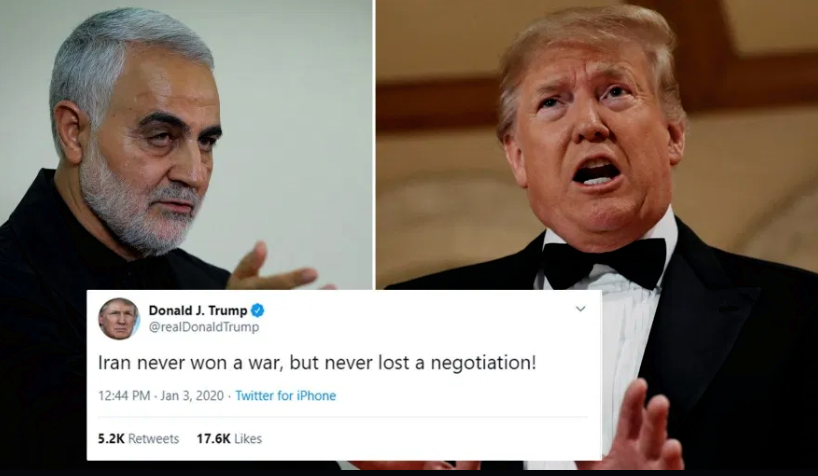The Conspiracy of Conscription
The decade seems to be off to a great start. The Chinese Coronavirus is scaring the entire world. A very deadly strain of the flu made this flu season more cough-filled than ever in recent memory. Australia has been experiencing the worst weather it has ever seen, alternating between deadly bushfires and dangerous flooding. Kobe Bryant and his daughter tragically died in a helicopter crash. Among the tension, the world was on the edge as it braced for another war seemingly begging to happen.
The conflict in question is the assassination of Qasem Soleimani, the Iranian general killed in an airstrike initiated by the United States. In this now controversial event, President Trump ordered a targeted drone strike targeting Soleimani in Baghdad International Airport. While the ethics and whether or not this was a good decision would be argued by pundits for days to come, something else was boiling on the internet. Immediately following the news of the attack, the hashtags “WWIII” and “Trump’s War” started trending on social media. Interestingly, among the crazed tweets about war and the general fear, the topic of conscription managed to creep its way back into the public conversation.
 Conscription, or the compulsory enrollment of persons especially for military service, as defined by Merriam-Webster (also known as “the draft”) has been around in the United States for a long time and has been used in almost every U.S. war until the Vietnam War, where it formally died in 1973. Since then, Congress has revisited the idea, especially post-9/11 with the US’ involvement in Iraq, but most efforts were struck down to its unpopularity. Minor military service acts have been passed, such as the Selective Service System, but formal drafts have met their fates. So it comes to a particular surprise that the Selective Service System’s (the independent governmental organization that monitors a potential draft) website crashed following the announcement of the Souleimani attack. Why is it that there’s suddenly a renewed interest in the draft (or at least, a renewed conversation about it and ways of getting around it) and would one be even possible?
Conscription, or the compulsory enrollment of persons especially for military service, as defined by Merriam-Webster (also known as “the draft”) has been around in the United States for a long time and has been used in almost every U.S. war until the Vietnam War, where it formally died in 1973. Since then, Congress has revisited the idea, especially post-9/11 with the US’ involvement in Iraq, but most efforts were struck down to its unpopularity. Minor military service acts have been passed, such as the Selective Service System, but formal drafts have met their fates. So it comes to a particular surprise that the Selective Service System’s (the independent governmental organization that monitors a potential draft) website crashed following the announcement of the Souleimani attack. Why is it that there’s suddenly a renewed interest in the draft (or at least, a renewed conversation about it and ways of getting around it) and would one be even possible?
Conscription has been abolished since 1973 and as of now, reinstating it would both be unpopular and illegal (that is unless Congress creates a law to reinstate the draft and be signed by the President, meaning that the military isn’t allowed to instate a draft whenever they want unless allowed by Congress). However, there is the Selective Service System’s Database, which keeps a record of all eligible draftees if a draft were to be reinstated. It’s important to keep note that that the Selective Service System’s Database is NOT the draft, but the confusion is understandable; the database is virtually a draft without the drafting. So in regards to the possibility of a draft, it is possible, though highly unlikely due to the public backlash and anti-war sentiments following the announcement of the attack. As suspicious as it may be to have the Selective Service System in place, waiting to draft you at a minute’s notice, rest assured that a draft won’t be coming unless an actual war happens. Even then, as seen in the Vietnam War, a draft won’t necessarily be popular and sustain itself.
 Who, then, is to blame for the conspiracy of conscription? It’s safe to say that it’s most likely due to a result of humanity’s ability to draw conclusions too quickly following a highly publicized and political event. Trump’s presidency has been filled with many controversial events, but during a time where Middle East tensions are at a high, and Trump is being investigated for the Ukrainian scandal, bringing back the conscription doesn’t seem like an impossible situation to many people and the rapid speed at which we receive information only spreads fuel to the fire. After all, social media is well-known for its cancel culture, where they blow controversies out of proportion (no matter factual or not). In the end, conscription isn’t happening, even if the many memes tell you otherwise.
Who, then, is to blame for the conspiracy of conscription? It’s safe to say that it’s most likely due to a result of humanity’s ability to draw conclusions too quickly following a highly publicized and political event. Trump’s presidency has been filled with many controversial events, but during a time where Middle East tensions are at a high, and Trump is being investigated for the Ukrainian scandal, bringing back the conscription doesn’t seem like an impossible situation to many people and the rapid speed at which we receive information only spreads fuel to the fire. After all, social media is well-known for its cancel culture, where they blow controversies out of proportion (no matter factual or not). In the end, conscription isn’t happening, even if the many memes tell you otherwise.

Derek Wong is a senior who likes discussing hot topics relating to politics and the entertainment industry. He frequently participates in Model UN, loves...

